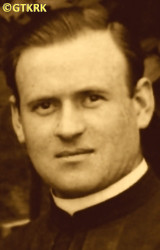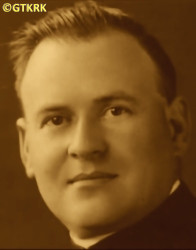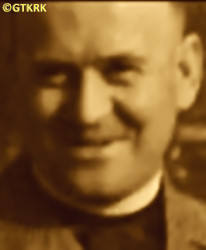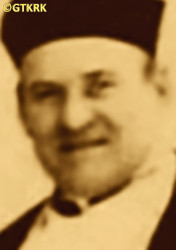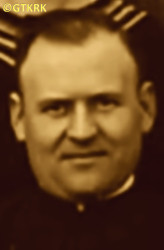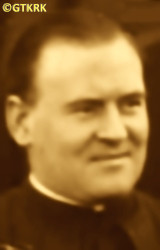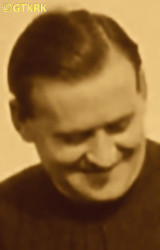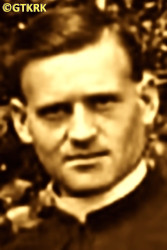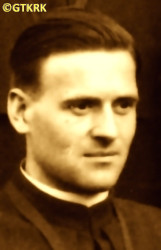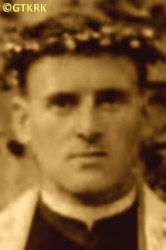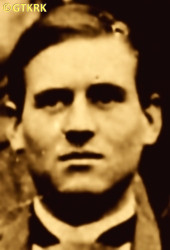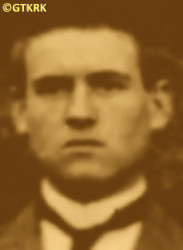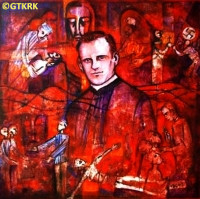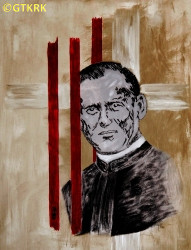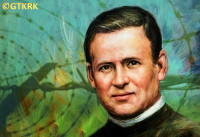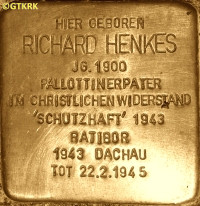Roman Catholic
St Sigismund parish
05-507 Słomczyn
85 Wiślana Str.
Konstancin deanery
Warsaw archdiocese, Poland
full list:
displayClick to display full list

searchClick to search full list by categories
wyświetlKliknij by wyświetlić pełną listę po polsku

szukajKliknij by przeszukać listę wg kategorii po polsku

Martyrology of the clergy — Poland
XX century (1914 – 1989)
personal data
religious status
blessed
surname
HENKES
forename(s)
Richard (pl. Ryszard)
function
diocesan priest
creed
Latin (Roman Catholic) Church RCmore on
en.wikipedia.org
[access: 2014.09.21]
congregation
Society of the Catholic Apostolate SACmore on
en.wikipedia.org
[access: 2013.05.19]
(i.e. Pallottines)
diocese / province
Olomouc archdiocesemore on
en.wikipedia.org
[access: 2014.10.31]
nationality
German
date and place
of death
22.02.1945

KL Dachauconcentration camp
today: Dachau, Upper Bavaria reg., Bavaria state, Germany
more on
en.wikipedia.org
[access: 2016.05.30]
alt. dates and places
of death
23.02.1945
details of death
During World War I soldier in the German army (c. 1918).
After German national–socialist party NSDAP took power in Germany in 01.1933 publicly criticized new regime. Interrogated by the German political police.
On 07.03.1937 arrested for the first time in home Ruppach–Goldhausen village.
Brought in front of court in Wrocław — accused of defamation in Kietrz of German national–socialist leader, Adolf Hitler, and falsely of pedophilia.
The sentence was not announced — amnesty announced after Anschluss, i.e. incorporation of Austria into Germany, included his case.
For safety, excluded by the Society from the group of teachers of Pallottine gymnasiums (in 1940, the German authorities closed them anyway and robbed their property — together with the convents accompanying them). Became a preacher and retreatist, soon known throughout Silesia.
On 08.04.1943 arrested by the German political police Gestapo — ostensibly for a sermon made in Branice critical of the regime (among others criticizing euthanasia of mental institutes' patients).
Held in Racibórz prison and then on 10.07.1943 transported to German KL Dachau concentration camp.
There volunteered to help the prisoners who contracted typhus fever — together with him c. 32 other Polish priests volunteered, among them the organizer, Fr Stephen Vincent Frelichowski, Fr Paul Januszewski, Fr Sigismund Mikołajewski, Fr George Stanislav Musiał, Fr Joseph Zapłata, Fr Stephen Zielonka — helped sick Chech prisoners, contracted typhoid himself and perished.
According to the death certificate, prepared in KL Dachau, the „honest” otherwise German „medical doctors” and formalists — and at the same time, unrivaled fairy tale spinners — noted that the cause of death was Germ. „Enterocolitis” (Eng. „Enterocolitis”).
prisoner camp's numbers
49642Click to display source page (KL DachauClick to display the description)
cause of death
extermination
perpetrators
Germans
sites and events
KL DachauClick to display the description, Ribbentrop‐MolotovClick to display the description, Pius XI's encyclicalsClick to display the description
date and place
of birth
26.05.1900

Ruppachtoday: Ruppach‐Goldhausen, Westerwald dist., Rhineland‐Palatinate state, Germany
more on
en.wikipedia.org
[access: 2022.08.05]
parents
HENKES Peter
🞲 1866, ? — 🕆 1939, ?

SCHLOTTER Anne Catherine
🞲 1862, ? — 🕆 1950, ?
baptism
18.05.1900

religious vows
25.09.1921 (temporary)
presbyter (holy orders)
ordination
06.06.1925

Limburg an der Lahntoday: Limburg‐Weilburg dist., Gießen reg., Hesse state, Germany
more on
en.wikipedia.org
[access: 2024.03.19]
positions held
1941 – 1943
parish priest — Strahovicetoday: Opava dist., Moravian‐Silesian reg., Czechia
more on
en.wikipedia.org
[access: 2022.08.05] ⋄ St Augustine RC parish
1940 – 1941
resident — Branicetoday: Branice gm., Głubczyce pov., Opole voiv., Poland
more on
en.wikipedia.org
[access: 2021.04.02] ⋄ retreat house „for people of all walks of life”, Institute of Treatment and Care (Germ. Branitzer Heil– und Pflegeanstalt) for the mentally ill — retreatist and preacher
1937 – 1940
friar — Ząbkowice Śląskietoday: Ząbkowice Śląskie gm., Ząbkowice Śląskie pov., Lower Silesia voiv., Poland
more on
en.wikipedia.org
[access: 2010.08.11] ⋄ Society's house, Pallottines SAC — in 1938‐1940 retreat leader and preacher throughout Silesia, i.e. during men's pilgrimages to the St Anne sanctuary on St Anne's Hill;in 1937‐1938 teacher of German, Latin and history in a gymnasium run by the Society
1931 – 1937
friar — Kietrztoday: Kietrz gm., Głubczyce pov., Opole voiv., Poland
more on
en.wikipedia.org
[access: 2021.04.02] ⋄ Society's house (in the former palace of von Gaschin Silesian family), Pallottines SAC — teacher of German, Latin and history in a gymnasium run by the Society
1929 – 1931
friar — Schönstatttoday: part of Vallendar, Vallendar dist., Mayen‐Koblenz reg., Rhineland‐Palatinate state, Germany
more on
en.wikipedia.org
[access: 2022.06.29] ⋄ Society's house, Pallottines SAC — teacher of German, Latin and history, and a tutor for young people, at a boarding school for boys run by the Society
1928 – 1929
friar — Drüpttoday: district of Alpen, Wesel dist., Düsseldorf reg., North Rhine‐Westphalia state, Germany
more on
de.wikipedia.org
[access: 2023.08.31] ⋄ Society's house, Pallottines SAC — teacher of German, Latin and history, and a tutor for young people, at a boarding school for boys run by the Society
1926 – 1928
friar — Schönstatttoday: part of Vallendar, Vallendar dist., Mayen‐Koblenz reg., Rhineland‐Palatinate state, Germany
more on
en.wikipedia.org
[access: 2022.06.29] ⋄ Society's house, Pallottines SAC — teacher of German, Latin and history, and a tutor for young people, at a boarding school for boys run by the Society
1920 – 1925
student — Limburg an der Lahntoday: Limburg‐Weilburg dist., Gießen reg., Hesse state, Germany
more on
en.wikipedia.org
[access: 2024.03.19] ⋄ philosophy and theology, Theological Seminary
1919 – 1921
novitiate — Limburg an der Lahntoday: Limburg‐Weilburg dist., Gießen reg., Hesse state, Germany
more on
en.wikipedia.org
[access: 2024.03.19] ⋄ Society's house, Pallottines SAC
1919
accession — Limburg an der Lahntoday: Limburg‐Weilburg dist., Gießen reg., Hesse state, Germany
more on
en.wikipedia.org
[access: 2024.03.19] ⋄ Society's house, Pallottines SAC
others related
in death
FRELICHOWSKIClick to display biography Steven Vincent, JANUSZEWSKIClick to display biography Paul (Fr Hillary), MIKOŁAJEWSKIClick to display biography Sigismund, MUSIAŁClick to display biography George Stanislav, ZAPŁATAClick to display biography Joseph (Bro. Dominic), ZIELONKAClick to display biography Steven
sites and events
descriptions
KL Dachau: KL Dachau in German Bavaria, set up in 1933, became the main German Germ. Konzentrationslager (Eng. concentration camp) KL for Catholic priests and religious during World War II: On c. 09.11.1940, Reichsführer‐SS Heinrich Himmler, head of the SS, Gestapo and German police, as a result of the Vatican's intervention, decided to transfer all clergymen detained in various concentration camps to KL Dachau camp. The first major transports took place on 08.12.1940. In KL Dachau Germans held approx. 3,000 priests, including 1,800 Poles. The priests were forced to slave labor in the Germ. „Die Plantage” — the largest herb garden in Europe, managed by the genocidal SS, consisting of many greenhouses, laboratory buildings and arable land, where experiments with new natural medicines were conducted — for many hours, without breaks, without protective clothing, no food. They slaved in construction, e.g. of camp's crematorium. In the barracks ruled hunger, freezing cold in the winter and suffocating heat during the summer, especially acute in 1941‐1942. Prisoners suffered from bouts of illnesses, including tuberculosis. Many were victims of murderous „medical experiments” — in 11.1942 c. 20 were given phlegmon injections; in 07.1942 to 05.1944 c. 120 were used by for malaria experiments. More than 750 Polish clerics where murdered by the Germans, some brought to TA Hartheim euthanasia centre set up in Schloss Hartheim in Austria and murdered in gas chambers. At its peak KL Dachau concentration camps’ system had nearly 100 slave labour sub‐camps located throughout southern Germany and Austria. There were c. 32,000 documented deaths at the camp, and thousands perished without a trace. C. 10,000 of the 30,000 inmates were found sick at the time of liberation, on 29.04.1945, by the USA troops… (more on: www.kz-gedenkstaette-dachau.deClick to attempt to display webpage
[access: 2013.08.10], en.wikipedia.orgClick to attempt to display webpage
[access: 2016.05.30])
Ribbentrop‐Molotov: Genocidal Russian‐German alliance pact between Russian leader Joseph Stalin and German leader Adolf Hitler signed on 23.08.1939 in Moscow by respective foreign ministers, Mr. Vyacheslav Molotov for Russia and Joachim von Ribbentrop for Germany. The pact sanctioned and was the direct cause of joint Russian and German invasion of Poland and the outbreak of the World War II in 09.1939. In a political sense, the pact was an attempt to restore the status quo ante before 1914, with one exception, namely the „commercial” exchange of the so‐called „Kingdom of Poland”, which in 1914 was part of the Russian Empire, fore Eastern Galicia (today's western Ukraine), in 1914 belonging to the Austro‐Hungarian Empire. Galicia, including Lviv, was to be taken over by the Russians, the „Kingdom of Poland” — under the name of the General Governorate — Germany. The resultant „war was one of the greatest calamities and dramas of humanity in history, for two atheistic and anti‐Christian ideologies — national and international socialism — rejected God and His fifth Decalogue commandment: Thou shall not kill!” (Abp Stanislav Gądecki, 01.09.2019). The decisions taken — backed up by the betrayal of the formal allies of Poland, France and Germany, which on 12.09.1939, at a joint conference in Abbeville, decided not to provide aid to attacked Poland and not to take military action against Germany (a clear breach of treaty obligations with Poland) — were on 28.09.1939 slightly altered and made more precise when a treaty on „German‐Russian boundaries and friendship” was agreed by the same murderous signatories. One of its findings was establishment of spheres of influence in Central and Eastern Europe and in consequence IV partition of Poland. In one of its secret annexes agreed, that: „the Signatories will not tolerate on its respective territories any Polish propaganda that affects the territory of the other Side. On their respective territories they will suppress all such propaganda and inform each other of the measures taken to accomplish it”. The agreements resulted in a series of meeting between two genocidal organization representing both sides — German Gestapo and Russian NKVD when coordination of efforts to exterminate Polish intelligentsia and Polish leading classes (in Germany called «Intelligenzaktion», in Russia took the form of Katyń massacres) where discussed. Resulted in deaths of hundreds of thousands of Polish intelligentsia, including thousands of priests presented here, and tens of millions of ordinary people,. The results of this Russian‐German pact lasted till 1989 and are still in evidence even today. (more on: en.wikipedia.orgClick to attempt to display webpage
[access: 2015.09.30])
Pius XI's encyclicals: Facing the creation of two totalitarian systems in Europe, which seemed to compete with each other, though there were more similarities than contradictions between them, Pope Pius XI issued in 03.1937 (within 5 days) two encyclicals. In the „Mit brennender Sorge” (Eng. „With Burning Concern”) published on 14.03.1938, condemned the national socialism prevailing in Germany. The Pope wrote: „Whoever, following the old Germanic‐pre‐Christian beliefs, puts various impersonal fate in the place of a personal God, denies the wisdom of God and Providence […], whoever exalts earthly values: race or nation, or state, or state system, representatives of state power or other fundamental values of human society, […] and makes them the highest standard of all values, including religious ones, and idolizes them, this one […] is far from true faith in God and from a worldview corresponding to such faith”. On 19.03.1937, published „Divini Redemptoris” (Eng. „Divine Redeemer”), in which criticized Russian communism, dialectical materialism and the class struggle theory. The Pope wrote: „Communism deprives man of freedom, and therefore the spiritual basis of all life norms. It deprives the human person of all his dignity and any moral support with which he could resist the onslaught of blind passions […] This is the new gospel that Bolshevik and godless communism preaches as a message of salvation and redemption of humanity”… Pius XI demanded that the established human law be subjected to the natural law of God , recommended the implementation of the ideal of a Christian state and society, and called on Catholics to resist. Two years later, National Socialist Germany and Communist Russia came together and started World War II. (more on: www.vatican.vaClick to attempt to display webpage
[access: 2023.05.28], www.vatican.vaClick to attempt to display webpage
[access: 2023.05.28])
sources
personal:
pl.wikipedia.orgClick to attempt to display webpage
[access: 2019.10.13], sbc.org.plClick to attempt to display webpage
[access: 2019.10.13], www.youtube.comClick to attempt to display webpage
[access: 2019.10.13]
bibliographical:
„Catholic Church in Głubczyce region in 1742‐1945”, Catherine Maler, vol. I and II, with erratum
„International Tracing Service (ITS), Bad Arolsen, GermanyClick to display source page”, Arolsen Archives
original images:
commons.wikimedia.orgClick to attempt to display webpage
[access: 2019.10.13], www.youtube.comClick to attempt to display webpage
[access: 2019.10.13], www.youtube.comClick to attempt to display webpage
[access: 2019.10.13], www.youtube.comClick to attempt to display webpage
[access: 2019.10.13], www.youtube.comClick to attempt to display webpage
[access: 2019.10.13], www.youtube.comClick to attempt to display webpage
[access: 2019.10.13], www.youtube.comClick to attempt to display webpage
[access: 2019.10.13], www.youtube.comClick to attempt to display webpage
[access: 2019.10.13], www.youtube.comClick to attempt to display webpage
[access: 2019.10.13], www.youtube.comClick to attempt to display webpage
[access: 2019.10.13], www.youtube.comClick to attempt to display webpage
[access: 2019.10.13], www.youtube.comClick to attempt to display webpage
[access: 2019.10.13], www.youtube.comClick to attempt to display webpage
[access: 2019.10.13], glaube-hat-zukunft.deClick to attempt to display webpage
[access: 2019.10.13], pfarrei-sankt-laurentius.bistumlimburg.deClick to attempt to display webpage
[access: 2019.10.13], commons.wikimedia.orgClick to attempt to display webpage
[access: 2019.10.13], commons.wikimedia.orgClick to attempt to display webpage
[access: 2019.10.13]
LETTER to CUSTODIAN/ADMINISTRATOR
If you have an Email client on your communicator/computer — such as Mozilla Thunderbird, Windows Mail or Microsoft Outlook, described at WikipediaPatrz:
en.wikipedia.org, among others — try the link below, please:
LETTER to CUSTODIAN/ADMINISTRATORClick and try to call your own Email client
If however you do not run such a client or the above link is not active please send an email to the Custodian/Administrator using your account — in your customary email/correspondence engine — at the following address:

giving the following as the subject:
MARTYROLOGY: HENKES Richard
To return to the biography press below:
 Click to return to biography
Click to return to biography








